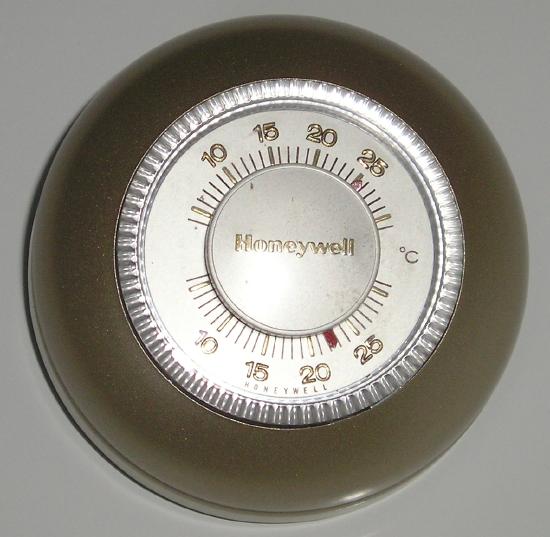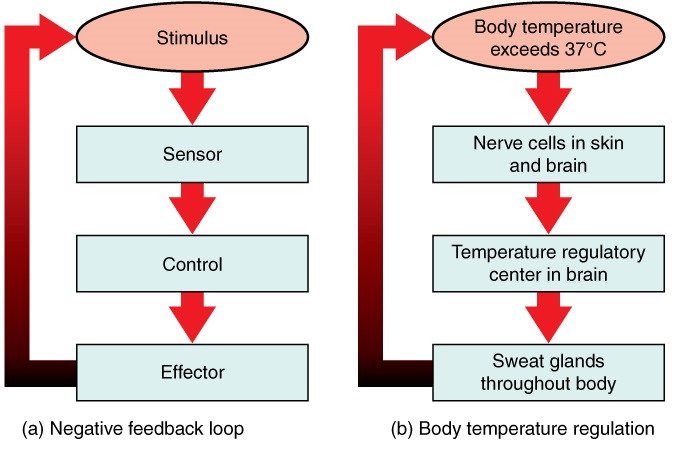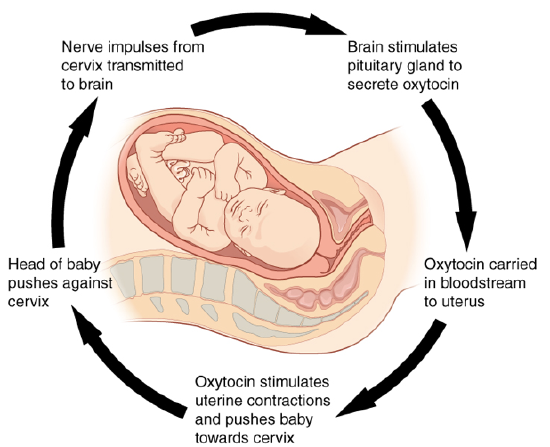Which Feedback Loop Stops the Original Stimulus From Continuing
10.7: Homeostasis and Feedback
- Page ID
- 17075
This device looks simple, but it controls a complex system that keeps a home at a steady temperature. The device is an old-fashioned thermostat. The dial shows the current temperature in the room and also allows the occupant to set the thermostat to the desired temperature. A thermostat is a commonly cited model of how living systems, including the human body, maintain a steady state called homeostasis.

What is Homeostasis?
Homeostasis is the condition in which a system such as the human body is maintained in a more-or-less steady state. It is the job of cells, tissues, organs, and organ systems throughout the body to maintain many different variables within narrow ranges that are compatible with life. Keeping a stable internal environment requires continuous monitoring of the internal environment and constantly making adjustments to keep things in balance.
Setpoint and Normal Range
For any given variable, such as body temperature or blood glucose level, there is a particular setpoint that is the physiological optimum value. For example, the setpoint for human body temperature is about 37 ºC (98.6 ºF). As the body works to maintain homeostasis for temperature or any other internal variable, the value typically fluctuates around the set point. Such fluctuations are normal as long as they do not become too extreme. The spread of values within which such fluctuations are considered insignificant is called the normal range. In the case of body temperature, for example, the normal range for an adult is about 36.5 to 37.5 ºC (97.7 to 99.5 ºF).
Maintaining Homeostasis
Homeostasis is normally maintained in the human body by an extremely complex balancing act. Regardless of the variable being kept within its normal range, maintaining homeostasis requires at least four interacting components: stimulus, sensor, control center, and effector.
- The stimulus is provided by the variable that is being regulated. Generally, the stimulus indicates that the value of the variable has moved away from the set point or has left the normal range.
- The sensor monitors the values of the variable and sends data on it to the control center.
- The control center matches the data with normal values. If the value is not at the set point or is outside the normal range, the control center sends a signal to the effector.
- The effector is an organ, gland, muscle, or other structure that acts on the signal from the control center to move the variable back toward the set point.
Each of these components is illustrated in Figure \(\PageIndex{2}\). The diagram on the left is a general model showing how the components interact to maintain homeostasis. The stimulus activates the sensor. The sensor activates the control system that regulates the effector. The diagram on the right shows the example of body temperature. From the diagrams, you can see that maintaining homeostasis involves feedback, which is data that feeds back to control a response. High body temperature may stimulate the temperature regulatory center of the brain to activate the sweat glands to bring the body temperature down. When body temperature reaches normal range, it acts as negative feedback to stop the process. Feedback may be negative or positive. All the feedback mechanisms that maintain homeostasis use negative feedback. Biological examples of positive feedback are much less common.

Negative Feedback
In a negative feedback loop, feedback serves to reduce an excessive response and keep a variable within the normal range. Examples of processes controlled by negative feedback include body temperature regulation and control of blood glucose.
Body Temperature
Body temperature regulation involves negative feedback whether it lowers the temperature or raises it (Figure \(\PageIndex{3}\)).
Cooling Down
The human body's temperature regulatory center is the hypothalamus in the brain. When the hypothalamus receives data from sensors in the skin and brain that body temperature is higher than the setpoint, it sets into motion the following responses:
- Blood vessels in the skin dilate (vasodilation) to allow more blood from the warm body core to flow close to the surface of the body, so heat can be radiated into the environment.
- As blood flow to the skin increases, sweat glands in the skin are activated to increase their output of sweat (diaphoresis). When the sweat evaporates from the skin surface into the surrounding air, it takes the heat with it.
- Breathing becomes deeper, and the person may breathe through the mouth instead of the nasal passages. This increases heat loss from the lungs.

Heating Up
When the brain's temperature regulatory center receives data that body temperature is lower than the setpoint, it sets into motion the following responses:
- Blood vessels in the skin contract (vasoconstriction) to prevent blood from flowing close to the surface of the body. This reduces heat loss from the surface.
- As the temperature falls lower, random signals to skeletal muscles are triggered, causing them to contract. This causes shivering, which generates a small amount of heat.
- The thyroid gland may be stimulated by the brain (via the pituitary gland) to secrete more thyroid hormones. This hormone increases metabolic activity and heat production in cells throughout the body.
- The adrenal glands may also be stimulated to secrete the hormone adrenaline. This hormone causes the breakdown of glycogen (the carbohydrate used for energy storage in animals) to glucose, which can be used as an energy source. This catabolic chemical process is exothermic, or heat producing.
Blood Glucose
In the control of the blood glucose level, certain endocrine cells in the pancreas called alpha and beta cells, detect the level of glucose in the blood. Then they respond appropriately to keep the level of blood glucose within the normal range.
- If the blood glucose level rises above the normal range, pancreatic beta cells release the hormone insulin into the bloodstream. Insulin signals cells to take up the excess glucose from the blood until the level of blood glucose decreases to the normal range.
- If the blood glucose level falls below the normal range, pancreatic alpha cells release the hormone glucagon into the bloodstream. Glucagon signals cells to break down stored glycogen to glucose and release the glucose into the blood until the level of blood glucose increases to the normal range.
Positive Feedback
In a positive feedback loop, feedback serves to intensify a response until an endpoint is reached. Examples of processes controlled by positive feedback in the human body include blood clotting and childbirth.
Blood Clotting
When a wound causes bleeding, the body responds with a positive feedback loop to clot the blood and stop blood loss. Substances released by the injured blood vessel wall begin the process of blood clotting. Platelets in the blood start to cling to the injured site and release chemicals that attract additional platelets. As the platelets continue to amass, more of the chemicals are released and more platelets are attracted to the site of the clot. The positive feedback accelerates the process of clotting until the clot is large enough to stop the bleeding.

Childbirth
Figure \(\PageIndex{4}\) shows the positive feedback loop that controls childbirth. The process normally begins when the head of the infant pushes against the cervix. This stimulates nerve impulses, which travel from the cervix to the hypothalamus in the brain. In response, the hypothalamus sends the hormone oxytocin to the pituitary gland, which secretes it into the bloodstream so it can be carried to the uterus. Oxytocin stimulates uterine contractions, which push the baby harder against the cervix. In response, the cervix starts to dilate in preparation for the passage of the baby. This cycle of positive feedback continues, with increasing levels of oxytocin, stronger uterine contractions, and wider dilation of the cervix until the baby is pushed through the birth canal and out of the body. At that point, the cervix is no longer stimulated to send nerve impulses to the brain, and the entire process stops.
When Homeostasis Fails
Homeostatic mechanisms work continuously to maintain stable conditions in the human body. Sometimes, however, the mechanisms fail. When they do, homeostatic imbalance may result, in which cells may not get everything they need or toxic wastes may accumulate in the body. If homeostasis is not restored, the imbalance may lead to disease or even death. Diabetes is an example of a disease caused by homeostatic imbalance. In the case of diabetes, blood glucose levels are no longer regulated and may be dangerously high. Medical intervention can help restore homeostasis and possibly prevent permanent damage to the organism.
Diabetes is diagnosed in people who have abnormally high levels of blood glucose after fasting for at least 12 hours. A fasting level of blood glucose below 100 is normal. A level between 100 and 125 places you in the pre-diabetes category, and a level higher than 125 results in a diagnosis of diabetes.
Of the two types of diabetes, type 2 diabetes is the most common, accounting for about 90 percent of all cases of diabetes in the United States. Type 2 diabetes typically starts after the age of 40. However, because of the dramatic increase in recent decades in obesity in younger people, the age at which type 2 diabetes is diagnosed has fallen. Even children are now being diagnosed with type 2 diabetes. Today, about 30 million Americans have type 2 diabetes, and another 90 million have pre-diabetes.
You are likely to have your blood glucose level tested during a routine medical exam. If your blood glucose level indicates that you have diabetes, it may come as a shock to you because you may not have any symptoms of the disease. You are not alone, because as many as one in four diabetics does not know they have the disease. Once the diagnosis of diabetes sinks in, you may be devastated by the news. Diabetes can lead to heart attacks, strokes, blindness, kidney failure, and loss of toes or feet. The risk of death in adults with diabetes is 50 percent greater than it is in adults without diabetes, and diabetes is the seventh leading cause of death in adults. In addition, controlling diabetes usually requires frequent blood glucose testing, watching what and when you eat and taking medications or even insulin injections. All of this may seem overwhelming.
The good news is that changing your lifestyle may stop the progression of type 2 diabetes or even reverse it. Here's how:
- Lose weight. Any weight loss is beneficial. Losing as little as seven percent of your weight may be all that is needed to stop diabetes in its tracks. It is especially important to eliminate excess weight around your waist.
- Exercise regularly. You should try to exercise five days a week for at least 30 minutes. This will not only lower your blood sugar and help your insulin work better; it will also lower your blood pressure and improve your heart health. Another bonus of exercise is that it will help you lose weight by increasing your basal metabolic rate.
- Adopt a healthy diet. Decrease your consumption of refined carbohydrates such as sweets and sugary drinks. Increase your intake of fiber-rich foods such as fruits, vegetables, and whole grains. About a quarter of each meal should consist of high-protein foods, such as fish, chicken, dairy products, legumes, or nuts.
- Control stress. Stress can increase your blood glucose and also raise your blood pressure and risk of heart disease. When you feel stressed out, do breathing exercises or take a brisk walk or jog. Also, try to replace stressful thoughts with more calming ones.
- Establish a support system. Enlist the help and support of loved ones as well as medical professionals such as a nutritionist and diabetes educator. Having a support system will help ensure that you are on the path to wellness and that you can stick to your plan.
Review
- What is homeostasis?
- Define the setpoint and normal range for physiological measures.
- Identify and define the four interacting components that maintain homeostasis in feedback loops.
- Compare and contrast negative and positive feedback loops.
- Explain how negative feedback controls body temperature.
- Give two examples of physiological processes that are controlled by positive feedback loops.
- A negative feedback loop:
- brings a variable's level back to a normal range
- can lower, but not raise, body temperature
- is the type of feedback involved in blood clotting
- A and B
- During breastfeeding, the stimulus of the baby sucking on the nipple increases the amount of milk produced by the mother. The more sucking, the more milk is usually produced.
- Is this an example of negative or positive feedback? Explain your answer.
- What do you think might be the evolutionary benefit of the milk production regulation mechanism described in part a?
- Explain why homeostasis is regulated by negative feedback loops, rather than positive feedback loops.
- A setpoint is usually:
- the top of a normal range
- the bottom of a normal range
- in the middle of a normal range
- the point at which changes can no longer occur
- The level of a sex hormone, testosterone (T), is controlled by negative feedback. Another hormone, gonadotropin-releasing hormone (GnRH), is released by the hypothalamus of the brain, which triggers the pituitary gland to release luteinizing hormone (LH). LH stimulates the gonads to produce T. When there is too much T in the bloodstream, it feeds back on the hypothalamus, causing it to produce less GnRH. While this does not describe all the feedback loops involved in regulating T, answer the following questions about this particular feedback loop.
- What is the stimulus in this system? Explain your answer.
- What is the control center in this system? Explain your answer.
- What is the pituitary considered in this system: stimulus, sensor, control center, or effector? Explain your answer.
Explore More
desrosierssympurs.blogspot.com
Source: https://bio.libretexts.org/Bookshelves/Human_Biology/Book%3A_Human_Biology_(Wakim_and_Grewal)/10%3A_Introduction_to_the_Human_Body/10.7%3A_Homeostasis_and_Feedback
0 Response to "Which Feedback Loop Stops the Original Stimulus From Continuing"
Postar um comentário